Subscription information. Disclaimer, copyright and licensing
Introduction
The lucerne leafcutting bee (Megachile rotundata) (Figure 1) is the foundation of a multi-million dollar pollination industry in North America, not only for lucerne (Medicago sativa) but other crops such as oil seed rape (OSR) cranberries and blueberries, for example, in Canada half the OSR is pollinated by lucerne leafcutting bees [1].

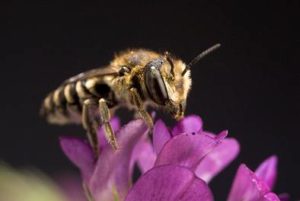

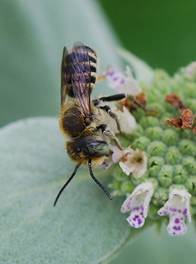
Figure 1. The lucerne leafcutting bee (Megachile rotundata) left image www.pollinator.ca, right image Pennsylvania Department of Agriculture
The lucerne, or alfalfa leafcutting bee as the North Americans call it, accidentally reached the Americas in the 1940s from its native Europe, and was imported from the USA and Canada to New Zealand in 1971 to 1984, when a considerable amount of research was undertaken and an industry established, until the breakup of DSIR which resulted in disbandment of the project. Fortunately one of the original scientists, Dr Barry Donovan (Figure 2), now of Donovan Scientific Insect Research, has recently been working to re-establish the industry. This work is looking increasingly timely due to a number of factors.
- There is a gold rush into manuka honey by New Zealand bee keepers which is dramatically reducing the amount of honey bee hives availability for crop pollination and where they are available, the price is going up dramatically.
- Honey bees have increasing health problems, starting with the varroa mite, then colony collapse disorder and there are now concerns about the newly identified parasite Lotmaria passim.
- Moving honey bees for pollination and ensuring sufficient bees not easy as bees have to be moved at night and it impacts the bees. Leafcutting bees can be easily shipped and their emergence accurately timed with crop flowering.
- Lucerne is being promoted by Prof. Derrick Moot and team at Lincoln university as the smartest, sustainable and most profitable way to manage NZ dryland stock farms www.lincoln.ac.nz/dryland. The amount of lucerne being grown is increasing spectacularly, but most seed is imported because of a lack of local production. Leafcutting bees can create a home grown lucerne seed industry and produce additional income for dryland farmers.
- Pollinating vegetable seed crops, especially carrots is difficult, but there are indications that leafcutting bees are a good, if not better, alternative to honey bees.
- The production of leafcutting bees for crop pollination in North America is now a multi-million dollar industry, and NZ has the potential, due to low leafcutting bee pest and disease levels, to sell bees into the N American market and elsewhere.
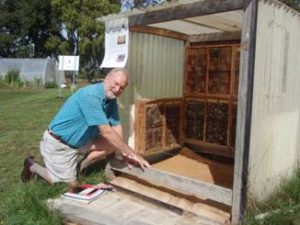
Figure 2. Dr Barry Donovan of Donovan Scientific Insect Research beside lucerne leafcutting bee hive
What are lucerne leafcutting bees?
Unlike honey bees that live in colonies, leafcutting bees are solitary but gregarious – i.e., they work alone but like each others company, which is what allows them to be managed. Also, they will not sting unless squashed, so no protective clothing is required (Figure 2). Their most preferred plant is lucerne, both as a source of pollen & nectar, and leaf material which they use to build the cells which house their young. They will however use a range of other crop plants and weeds for food and leaves. The females create their cells out of ovals cut from leaves, placing them in small holes and cracks, then provisioning them with pollen and nectar on which the larva feeds and then pupates in the cell. Typically only one generation is produced per year, with the species overwintering as larvae in the cells. This is the other aspect of leafcutting bees that makes them manageable and valuable for pollination. Artificial nests / ‘hives’ are created which consists of lots of 6 mm diameter holes (Figure 3). The bees create multiple leaf cells in these holes (Figure 4), which can then be recovered at the end of the season and refrigerated for about eight months. In that time the cells can be shipped anywhere in NZ or overseas, ready for pollinating the next crop on time. This compares very favourably with honey bees which have to be moved as whole hives, at night. This is the basis for the leafcutting bee industry in N America – selling cells to farmers and growers to pollinate a range of crops. Also, some leafcutting bee keepers run contract pollination services.

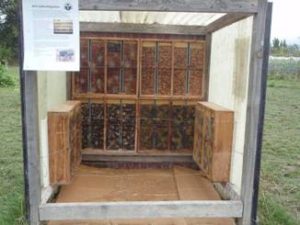
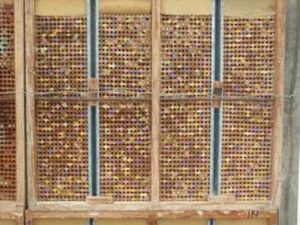

Figure 3. Lucerne leafcutting bee hive.

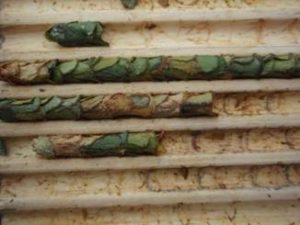
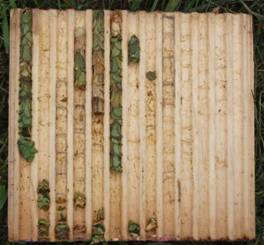

Figure 4. Grooved bee nest boards and individual bee cells.
Lucerne pollination
To be effectively pollinated the lucerne flower has to be ‘tripped’ which is where the anthers spring out of the flower and strike the bee on the underside. The problem is that honey bees do not like this and they quickly learn to get the nectar without tripping the flower, so it fails to pollinate. Also lucerne pollen is missing the essential amino acid isoleucine which means honey bees suffer protein stress when only working lucerne. As a lucerne specialist, the leafcutting bee is unsurprisingly much better at pollinating lucerne. Work done in the early 1980s in New Zealand showed that lucerne seed yields increased from around 70 kg / ha to between 350 to 517 kg / ha [2], a 370% to 590% increase! Gross margins indicated that the entire capital cost would be more than recovered in the first year, indeed capital could be repaid several fold [2].
Management / lifecycle
Management of lucerne leafcutting bees is relatively straight forward, but, it has to be done correctly to be successful. The downloads at the end of this article, and a wide range of information on the internet from N America, provide full details.
As noted above the larvae in their leaf cells are kept refrigerated for about eight months of the year. About 21 days prior to the crop starting flowering, the larvae in their cells are warmed up in controlled conditions which causes them to pupate and then emerge ready for action. This is another valuable attribute as bee presence and activity can be precisely timed to crop requirements.
The bees are then released into the field into simple, but carefully designed and placed shelters which houses the ‘hives’ – i.e., the 6 mm nesting holes. Another benefit of leafcutting bees is they will work the first suitable available flowers and like to stay as close to their hives as possible, unlike honey bees which if they find more preferable flowers elsewhere can completely ignore the crop they are placed in. The bees mate on emergence and although both sexes pollinate flowers only the females work to create the next generation while the males lounge around seeking to mate with females! The females cut ovals out of leaves to create the cell which they place in the holes. A lot of research was done in the United States to work out the best design of the hives and a system was developed where grooved boards when stacked up created the holes, so they could then be easily taken apart to retrieve the cells. Lots of other approaches have been tried and are used, including paper drinking straws, and solid blocks of wood with holes drilled in them.
Generally there is only one generation a year, i.e., the bees that emerge from over winter produce lots of progeny, but that progeny do not hatch the same year, rather they remain as larvae and overwinter themselves. Sometimes in good weather, the first generation may hatch and start producing a second generation, but in NZ conditions the second generation is not as large as the first, so it should be avoided. This is done by timing the release of bees and putting the cells into cold storage at the correct time. The correct time of cold storage is also the key to managing the main pest of leafcutting bees in NZ a small parasitic wasp Melittobia hawaiiensis that is native to NZ but found globally. If the hives are left in the field too late in the season, parasitism levels rapidly increase to the point where all bee larvae can be lost. The leaf cells are then kept refrigerated until they are required for the next season when they are then shipped, warmed up, and released to pollinate the next crop.
Acknowledgements
Many thanks to Dr Barry Donavan for reviewing this article and providing most of the source material.
Resources
If you are interested in producing lucerne leafcutting bees in New Zealand please contact Dr Ron van Toor at ronald.vantoor@plantandfood.co.nz +64 27 285 2720.
All the key publications from NZ research from the 1980s is available below for download including the management handbook. Each is a ZIP file and contains scans / images (JPGs) as the originals were typed so no electronic versions exist.
There is also a wealth of information on the internet. When searching, use the taxonomic name “Megachile rotundata”, or the American name “alfalfa leafcutting bee” and “alfalfa leafcutter bee” (lucerne leafcutting bee is the Entomological Society of NZ standard common name, but many producers, especially in N America, use the term leafcutter bee).
Leafcutting bee life history, allocation details, and management techniques (main management handbook) 30 MB
Is leafcutting bee investment warranted? The answer is clearly “yes”! (NZ Journal of Agriculture article on financial benefits) 4 MB
Pitts-Singer, T. L. & Cane, J. H. (2011). The Alfalfa Leafcutting Bee, Megachile rotundata: The World’s Most Intensively Managed Solitary Bee. Annual Review of Entomology, 56(1), 221-237. http://www.annualreviews.org/doi/abs/10.1146/annurev-ento-120709-144836 (open access review article)
The following pollination reports, cover annual research outputs and management advice.
Pollination report 1 1979. 4 MB
Pollination report 2 1980. 8 MB
Pollination report 3 1981. 23 MB
Pollination report 4 1982. 17 MB
Pollination report 5 1983. 11 MB
Pollination report 6 1984. 10 MB
Efficacy of lucerne leafcutting bees as pollinators of lucerne in New Zealand. Journal paper, 6 MB
Seed production of new cultivars of lucerne. Journal paper, 2 MB
Selection and importation of new pollinators to New Zealand. Journal paper, 3 MB
References
1. Darrach, M. and Page, S., Statistical Overview of the Canadian Honey and Bee Industry and the Economic Contribution of Honey Bee Pollination, 2013-2014. 2016, Ottawa, Ontario: Horticulture and Cross Sectoral Division, Agriculture and Agri-Food Canada. ISBN 1925-380X. http://www.agr.gc.ca/resources/prod/doc/pdf/1453219857143-eng.pdf
2. Donovan, B. and Read, P., Is leafcutting bee investment warranted? The answer is clearly “yes”! The New Zealand Joural of Agriculture, 1984. 149(4): p. 2-3
